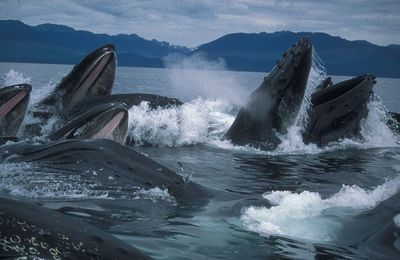Pollution and marine mammals
Main substances in marine mammals
Like sea birds, marine mammals are in all marine ecosystems at the top (or very near the top) of the food chain. As such, they are particularly sensitive towards bioaccumulating substances. Most studied are organochlorine pesticides (like DDTs), polychlorinated biphenyls (PCBs) and methylmercury.
The use of DDTs (since the 1970s) and PCBs (since 1991) has been banned in Europe. However because of their stability they are still present in marine ecosystems, even in very remote areas like Antarctica. Of course concentrations in Antarctica will be lower than those in the coastal areas where the discharges occurred.[1] Although marine mammals can accumulate large quantities of methylmercury, they rarely display any harmful effects of the contaminant. The reason for this is that marine mammals can transform methylmercuy into less harmful inorganic mercury, which can also efficiently be detoxified by selenium.
Toxicant related problems in marine mammals
In the past decades organochlorine-contaminant-related-mass-deaths have occurred in marine mammals. In Northern Europe, more then 20.000 seals have died in 1988 due to seal plague. It is believed that the seal plague virus caused this extent of damage because the resistance of the seals was lowered due to pollutants: a process called immunodeficiency. Later this virus caused mass mortalities of striped dolphins in the 1990-1992 period: More than 1000 dolphins died in the Mediterranean. Again it's believed that casualties were increased due to immunodeficiency caused by contaminants like PCBs. Actually proving the toxicological effects of contaminants in marine mammals is rather difficult due to logistical and ethical reasons. [2] Some marine mammals have reproductive difficulties which might be related to high concentrations of DDTs or PCBs, compounds which might act as endocrine disrupting compounds. Till today however, no marine mammal has died by the direct toxic effects of any organochlorine compound. Although marine mammals are usually capable of detoxifying mercury, there have been reports of mercury intoxication and related deaths in marine mammals in 1968. These deaths occurred in an area with heavy industrial mercury dumping. [3]
Below you can find some links to Belgian case studies on ecotoxicology in marine mammals.
Case studies
Case study 1: Toxic substances in beached sperm whales [4]
Case study 2:Organochlorine pesticides in Harbour porpoises [5]
References
- ↑ Kennish, M. J. (1996): Practical Handbook of Estuarine and Marine Pollution, CRC Press 524 pp
- ↑ Sinderman, C.J. 1996. Ocean Pollution: Effects on Living Resources and Humans. CRC Press, Boca Raton, FL. 275 pp
- ↑ New perspectives: Toxicology and the environment. Toxicology of marine mammals, eds.J. Vos, G. Bossart, M. Fournier, and T. O'Shea, New York: Taylor & Francis. 643p
- ↑ Holsbeek, L.; Joiris, C.R.; Debacker, V.; Ali, B.I.; Roose, P.; Nellissen, J.P.; Gobert, S.; Bouquegneau, J.-M.; Bossicart, M. (1999). Heavy metals, organochlorines and polycyclic aromatic hydrocarbons in sperm whales stranded in the southern North Sea during the 1994/1995 winter. Mar. Pollut. Bull. 38(4): 304-313
- ↑ Covaci, A.; Van de Vijver, K.; De Coen, W.; Das, K.; Bouquegneau, J.-M.; Blust, R.; Schepens, P. (2002). Determination of organohalogenated contaminants in liver of harbour porpoises (Phocoena phocoena) stranded on the Belgian North Sea coast. Mar. Pollut. Bull. 44(10): 1157-1169
Please note that others may also have edited the contents of this article.
|
